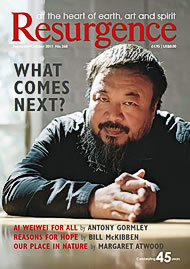If the green movement wishes to be radical and effective and wants to embrace a new paradigm of the future, then our work has to be based in harmony and wholeness incorporating spiritual wellbeing, artistic imagination, social cohesion and reverence for the whole of life.
Through the observation and analysis, experiment and evidence, reason and logic of our great scientists, we know the truth of harmony and the laws of Nature such as gravity, Gaia, relativity and evolution.
Through words, colours or images, music, movement, poetry and stories we communicate and express our experience of the universal harmony. And through reverence and restraint, through simplicity and frugality, reflection and meditation, synthesis and spirituality, dialogue and philosophy we learn to live in harmony with the universe and with ourselves.
But much of the environmental movement is missing out on this holistic approach.
Limiting itself to working within the partial parameters of secular rationalism, facts, figures and pragmatic arguments, the green movement has failed to make an impact on changing the direction of politics, business, academia and media. The culture of consumerism and materialism continues to intensify and there is little prospect of real change if we confine ourselves to green growth, renewable energy and very few other areas of policy.
We need to develop a bigger vision and to present a bigger picture to the world.
At the Tagore Festival earlier this year, Jonathon Porritt told his audience: “Today’s green movement is addicted to an empirical, secular rationalism oblivious to the spiritual connectivity between people and place.”
In this issue – in which we look at the positive ways in which we can embrace a more uplifting and new future – Jonathon explores this theme further, and in his article, respected biologist and author Colin Tudge does the same, making a strong case for a return to the place where the compatibility of science and spirituality was clearly understood by great scientists and thinkers as well as environmental activists.
Colin Tudge is right. Science alone is not enough; nor is spirituality by itself enough. We need science to appreciate the outer landscape, and we need spiritual awakening to nourish the inner landscape. Science equips us with the methods to relate to the material world, and spirituality helps us to find meaning in that world and in life. While science shows how, spirituality shows why we have to take good care of the Earth and ourselves and live in harmony with the world.
Again at the Tagore Festival, the Iranian Sufi scholar Hossein Ghomshei explained what he understood by the word ‘harmony’: “Harmony is the existential principle of the universe. Knowledge of universal harmony is science, expression of it is the arts, and the practice of harmony is religion. Which means there is no conflict between science, the arts and religion – all three operate within the context of the universal harmony.”
The sun is in harmony with the soil and the seeds, the oceans are in harmony with the land, bees are in harmony with flowers, and the five elements harmonise and cooperate with each other to maintain life on Earth.
We are all related.
“Reality is not a thing, reality is relationship amongst things,” says Iain McGilchrist, author of The Master and his Emissary. Reality is reciprocity and mutuality; dark and light, below and above, left and right complement.
And, in the words of E.M. Forster, all we have to do is “only connect”.
So the next step for the green movement is to re-launch itself from the platform of a big vision of universal harmony. Otherwise we remain a mere collection of pressure groups and self-serving organisations, busy seeking bigger funds, more members, and media headlines tweaking policies and business decisions here and there.








